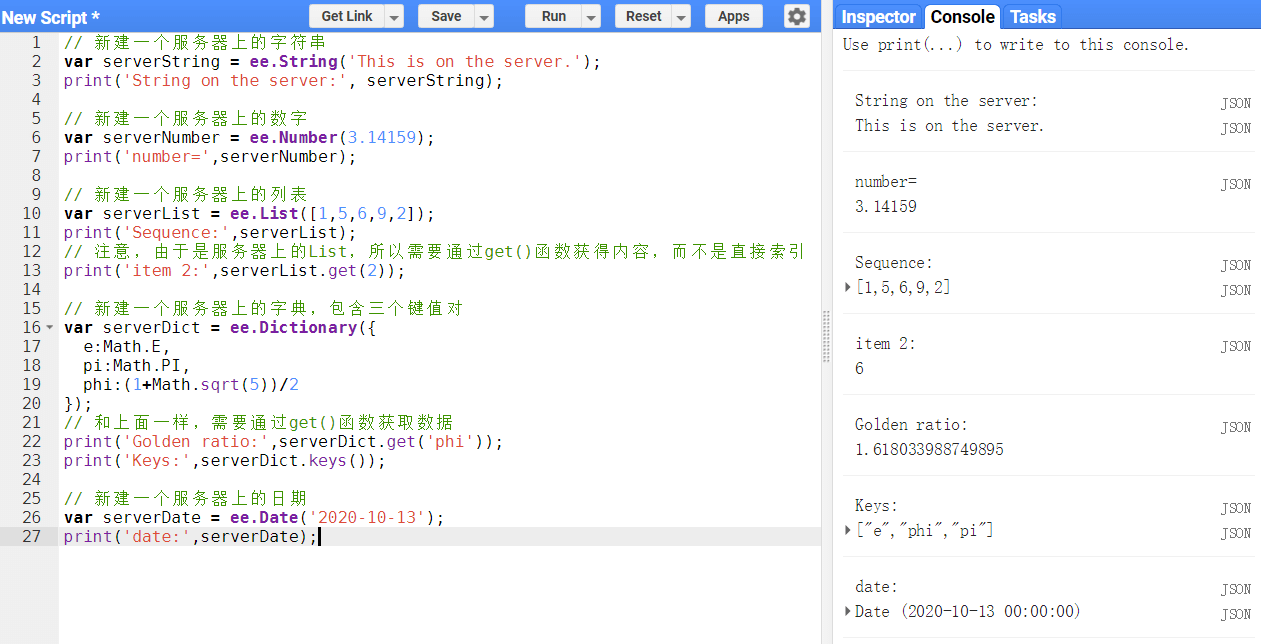https://earthengine.google.com/
Official Get-Started Tutorial: https://developers.google.com/earth-engine/guides/getstarted
Coding Best Practices. This page teaches how to code in GEE efficiently and avoid some bad practices.
Task Manager. Tasks like uploading and exporting to drive will appear here.
How to debug? https://developers.google.com/earth-engine/guides/debugging
This note is mainly written under the framework of the official handbook
Other links and resources:
- Google Earth (not only GEE) YTB channel: https://www.youtube.com/googleearth
Landsat collections: https://developers.google.com/earth-engine/datasets/catalog/landsat
About Landsat collection structures: https://developers.google.com/earth-engine/guides/landsat
| Mission | Time range | Best quality imagery | Notes |
|---|---|---|---|
| Landsat 9 | 2021-10-31T00:00:00Z to present | Level 2, Collection 2, Tier 1 | |
| Landsat 8 | 2013-03-18T15:58:14Z to present | Level 2, Collection 2, Tier 1 | |
| Landsat 7 | 1999-05-28T01:02:17Z to 2023-02-04T01:41:07 | Level 2, Collection 2, Tier 1 | ETM+ failed on May 31, 2013! |
Note that there are scale factors in Landsat bands!!!
The following code applies for Landsat 8 & 9. There is slight difference in thermal bands of Landsat 7.
// Applies scaling factors.
function applyScaleFactors(image) {
var opticalBands = image.select('SR_B.').multiply(0.0000275).add(-0.2);
var thermalBands = image.select('ST_B.*').multiply(0.00341802).add(149.0);
return image.addBands(opticalBands, null, true)
.addBands(thermalBands, null, true);
}
dataset = dataset.map(applyScaleFactors);| Original | After Scaling | |
|---|---|---|
SR_B.: |
|
-0.2 to 1.6 |
SR_B10: |
0 to 65535 (16 bit) | 149 to 373 K |
https://developers.google.com/earth-engine/datasets/catalog/sentinel-2, harmonized
Sentinel-2 User Handbook by ESA
Sentinel-2 Bands from Wikipedia
Repeating cycle: ~5 days
Scale factors for B* bands are all 10000.
https://www.earthdata.nasa.gov/esds/harmonized-landsat-sentinel-2
https://www.sciencedirect.com/science/article/pii/S0034425718304139
https://lpdaac.usgs.gov/documents/1007/HLS_User_Guide_V15_provisional.pdf
Sentinel-1 Algorithms: https://developers.google.com/earth-engine/guides/sentinel1
| Mission | Time range | Imagery |
|---|---|---|
| Sentinel-1 | 2014-10-03T00:00:00Z to present | S1 GRD |
Repeating cycle: 12 days
See Sentinel-1 Orbit
Common processing procedure
var collectionName = ee.ImageCollection('COPERNICUS/S1_GRD')
.filterBounds(aoi)
.filterDate(time_start, time_end)
.filter(ee.Filter.listContains('transmitterReceiverPolarisation', 'VH'))
.filter(ee.Filter.eq('orbitProperties_pass', 'ASCENDING'))
.filter(ee.Filter.eq('instrumentMode', 'IW'))
.select('VH')
.mosaic()
.sort('system:time_start', true);Orbit number (path):
relativeOrbitNumber_start:
Frame information is not included in the metadata as the frames are manually separated into images.
PALSAR-2 ScanSAR Level 2.2
https://developers.google.com/earth-engine/datasets/catalog/JAXA_ALOS_PALSAR-2_Level2_2_ScanSAR
Generate blank list:
var myList = ee.List.sequence(1, 10);Generate empty list:
var emptyList = ee.List([]);Add items to a list. Note that = must be applied otherwise there would be no update on the list.
var list = list.add(item);Convert an image collection to a list:
var imageList = imageCollection.toList(imageCollection.size());Vise versa, convert a list of images to an image collection:
var imageCollection = ee.ImageCollection.fromImages(imageList);or manually:
var imageCollection = ee.ImageCollection.fromImages([image1, image2, image3]);Visit items in a list by index:
var item = list.get(i);Note that an item selected by .get() will not retain its data type. So a typecast must be applied before using it as, for example, an image:
var image = ee.Image(list.get(i));var functionName = function(parameters) {
// Do something
return 0; // A return is required
};Note that a function is also a variable (?)
A function can also be written in another form:
function functionName(parameters) {
// Do something
return 0; // A return is required
};However only the first form is recommended in GEE, whereas you can also see form two in some scripts.
If you want to access a certain property in an image, simply imageName.propertyName
(however I saw somewhere else that it should be image.get()?)
The properties of an image is stored as a dictionary
Select a band out of an image: .select(bandName). Note that bandName can contain wildcard like . and *
mosaic() and qualityMosaic()
https://developers.google.com/earth-engine/apidocs/ee-date
A date can be either a ee.Date object or simply be a string(?really)
advance(60, 'day');, used to calculate time offset
var visParams = {min: -3, max: 3, palette: ['blue', 'white', 'red']};
Map.addLayer(DataName, visParams, 'Layer Name');Map.centerObject(AOI, ZoomLevel);Map.setCenter(lon, lat, ZoomLevel);Export.image.toDrive: https://developers.google.com/earth-engine/apidocs/export-image-todrive
https://developers.google.com/earth-engine/guides/exporting_map_tiles
About Cloud Storage buckets: https://cloud.google.com/storage/docs/buckets/
Google Cloud main page: https://console.cloud.google.com/
https://developers.google.com/earth-engine/guides/python_install
pip install earthengine-api此外还要安装gcloud
(New-Object Net.WebClient).DownloadFile("https://dl.google.com/dl/cloudsdk/channels/rapid/GoogleCloudSDKInstaller.exe", "$env:Temp\GoogleCloudSDKInstaller.exe")
& $env:Temp\GoogleCloudSDKInstaller.exe参考: https://cloud.google.com/sdk/docs/install
然后就是激活
ee.Authentiate()也可以在cmd中激活, 但是这种方式容易出现earthengine没有被添加到PATH的情况
earthengine authenticate激活后的密钥放在%UserProfile%\.config\earthengine\credentials中. 如果想要反激活的话只需移除密钥文件即可
此处
%UserProfile%为C:\Users\wcrpk
这一步是确保python的流量也走梯子, 以访问Google服务
import os
os.environ['HTTP_PROXY'] = 'http://127.0.0.1:5555'
os.environ['HTTPS_PROXY'] = 'http://127.0.0.1:5555'代理的地址和端口可以打开clash或者在Windows设置中的“代理”查看. 注意clash有随机端口模式, 可以关掉.
import ee
ee.Initialize()